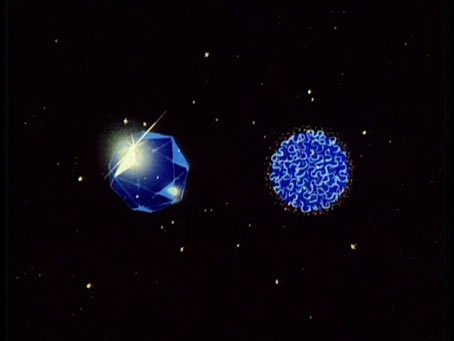
All irregularities will be handled by the forces controlling each dimension. Transuranic, heavy elements may not be used where there is life. Medium atomic weights are available: Gold, Lead, Copper, Jet, Diamond, Radium, Sapphire, Silver and Steel.
Sapphire and Steel have been assigned.
Voiceover at the beginning of each episode
Having revisited a fair amount of old television in the past few years I thought I was past being surprised, but this came as a revelation. Sapphire and Steel appeared at exactly the wrong moment for me to fully appreciate it the first time round. The six storylines ran on the ITV network from 1979 to 1982, a period when my home and personal life was so chaotic that I saw little television at all. At any other time a series featuring a pair of cosmic investigators immersed in mysteries involving haunted railway stations and people escaping from photographs would have been essential viewing. Sapphire and Steel was never repeated after those original screenings so watching the entire run recently has been like seeing it for the first time. In recent years the series has been included in discussion of the weirder British television of past decades; China Miéville in his interview in The Twilight Language of Nigel Kneale describes Sapphire and Steel as the strangest thing ever screened on British TV. After reading that, and a couple of other appraisals, I felt obliged to refresh my vague memories.
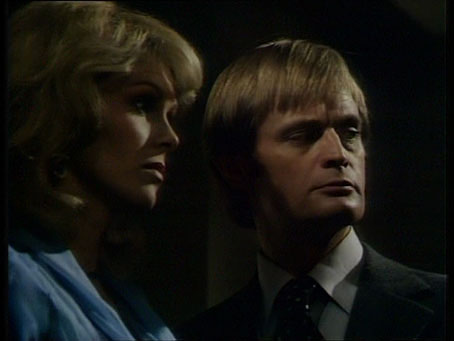
Assignment One: Sapphire (Joanna Lumley) and Steel (David McCallum).
Superficially, Sapphire and Steel belongs to the occult-detective subgenre, a minor category of weird fiction that in its early days included characters such as Sheridan Le Fanu’s Dr Martin Hesselius, Algernon Blackwood’s John Silence, William Hope Hodgson’s Thomas Carnacki and others. But several factors set Sapphire and Steel apart from their more staid predecessors: occult detectives are generally solitary figures whereas Sapphire and Steel operate as a pair; Sapphire is a woman in a field more commonly occupied by middle-aged men; and most striking of all, both Sapphire and Steel are supernatural beings themselves, dispatched to Earth by agencies we never see and learn nothing about, in order to mend ruptures in the flow of Time. Supernatural detectives had appeared in comic books before this but there’s no evidence that series creator PJ Hammond was considering such antecedents when he wrote The Time-Menders (as Sapphire and Steel was originally known). A few years earlier Hammond had been writing for Ace of Wands (1970–72), a mildly hippyish children’s TV series whose hero, Tarot, was a youthful stage magician with genuine occult powers. Between stage shows, Tarot and friends investigated supernatural events. Sapphire and Steel had originally been planned as a series for children but before the first script was finished it was moved to an early evening slot, thus allowing for darker and more adult-oriented material.
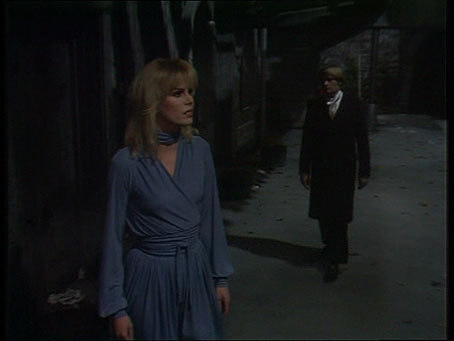
Assignment Two: the haunted railway station. The clothing worn by the pair changes with each assignment; on this occasion they’re in evening dress.
One of the attractions of Sapphire and Steel in a genre replete with origins and canonical histories is how little is explained about the two main characters, the source of their assignments, or even the true nature of the malevolent forces they have to face. Sapphire (Joanna Lumley) and Steel (David McCallum) embody the materials after which they’re named, the pair being part of a team of elemental operatives some of whose names are listed in the voiceover that introduces each episode. We only encounter two others: Lead (Val Pringle), a huge African-American man with superior strength; and Silver (David Collings), an effete and dandyish Englishman with the ability to mould metals, fix machines and replicate objects. Sapphire’s abilities are mainly psychometric—she reads the history and condition of people and places—but she can also rewind time for short periods; Steel is as cold and unyielding as his name; he’s fiercely analytical, often bad-tempered and also strong enough to tie a knot in a lift cable.
Assigning characters different elements has another precedent in American comics but DC’s Metal Men (who also included a character named Lead) were a group of robots whose adventures are the usual superhero fare. Personal characteristics aside, Sapphire and Steel are closer to Doctor Who‘s Time Lord as he was at the time the series was being broadcast (the Tom Baker/Peter Davison incarnations) albeit more remote and less sympathetic to human concerns. Steel is refreshingly callous in his attitude towards the human beings who happen to be caught up in the metaphysical drama; at the end of one storyline he even sacrifices the life of an unfortunate individual as a means of solving the crisis they all face, behaviour that you wouldn’t see from any of today’s eminently responsible heroes. Sapphire is a lot more friendly but only up to a point; the pair have a job to do, and often act as good cop/bad cop in order to get their human charges to cooperate. All the elementals can use telepathy to communicate which makes for some interesting scenes when they’re able to plan and discuss things without the humans knowing. Tarot in Ace of Wands was also telepathic but you rarely see a central character using the ability to duplicitous ends.
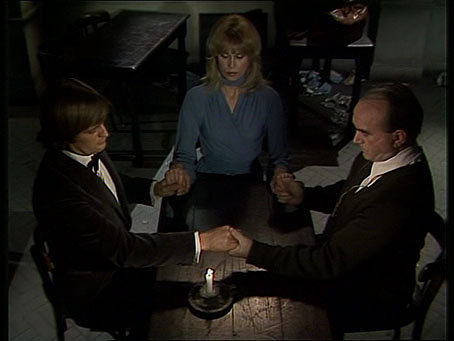
Assignment Two: the séance with Tully (Gerald James) the ghost-hunter.
If the two main characters are unusual, their casting is perfect: Lumley and McCallum fit their roles so well it’s it’s difficult to imagine any other actors taking their places. McCallum had been in film and television for many years but Steel is closest to Ilya Kuryakin, the cool Russian he played in The Man from U.N.C.L.E. Lumley’s most notable role prior to Sapphire was the karate-kicking Purdey in The New Avengers, a series I never liked since it seemed a poor relation to the Avengers series of the late 60s. I’d also never paid much attention to David McCallum’s acting prior to this viewing so another surprise was seeing how good he is as Steel, a much more impressive showing than in his short-lived US TV series The Invisible Man (1975). Lumley and McCallum work so well together that any scene that doesn’t include them seems diminished.
One of the more notable aspects of Sapphire and Steel from today’s perspective is the equal balance of the partnership. At the time the series was running, Doctor Who had given Tom Baker’s Doctor an almost equal partner in fellow Time Lord, Romana, but the series then (as now) had the Doctor’s exploits as its chief concern. Sapphire and Steel not only puts Sapphire at the front of the title but the stories make her an equal partner at all times. Steel relies on her particular abilities as much as she relies on his; sometimes Steel solves the problem they’ve been sent to investigate, at other times Sapphire does; both characters have to rescue each other at crucial moments.
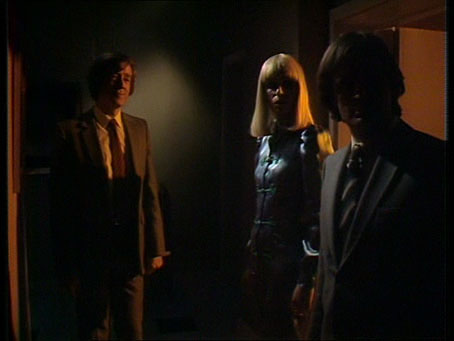
Assignment Three: the first appearance of Silver (David Collings, left).
Sapphire: “There is a corridor…
Steel (telepathically): It can’t be explained to him.
Sapphire (telepathically): It can, in a way. But not by you perhaps.
Sapphire: …There is a corridor, and the corridor is Time. It surrounds all things, and it passes through all things. But you can’t see it. Only sometimes. And it’s dangerous.
Rob: This corridor…can you enter it?
Sapphire: No, not in the way you imagine it, you cannot enter into Time. But sometimes Time can try to enter into the present. Break in. Burst through and take things. Take people. The corridor is very strong, it has to be, but sometimes, in some places, it becomes weakened, like fabric, worn fabric, and when there is pressure put on the fabric…
Rob: Time comes in…
Sapphire: …Reaches in and takes out what it wants. And we think that Time has broken into that room. Broken through, and taken away your parents.
Sapphire’s explanation to the two bereft children in Assignment One is all the explanation we’re given of the nature of the temporal ruptures that she and Steel have to deal with. (Each of the six storylines is a numbered assignment; fans of the series have subsequently given the assignments titles but PJ Hammond insists that this was never his intention.) Later on there’s some brief discussion about the unspecified, malignant entities that wait like HP Lovecraft’s Old Ones outside the corridor of Time, forever seeking entry into the material universe. A particularly horrifying manifestation is encountered in Assignment Two, a whispering shadow described as “the darkness” whose origin and true nature remains inexplicable. These manifestations draw the series away from science fiction into outright horror.
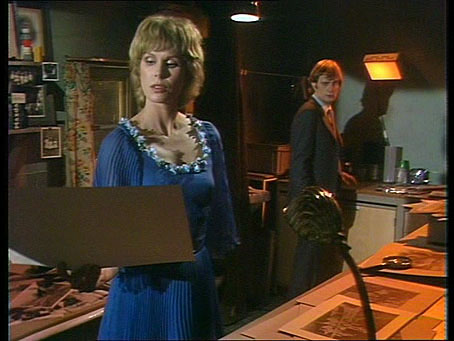
Assignment Four: exploring the darkroom.
Assignment One plays like a typical story for children, beginning with the disappearance of the parents. This establishes the pattern of the series in which a succession of isolated locations are sites for the “time-breaks”. Assignment Two, about an abandoned railway station haunted by dead soldiers, is markedly different, closer in tone to Nigel Kneale’s The Stone Tape especially in the way the spectral soldiers are only the first layer of a more terrifying haunting. This came across as the strongest story of the series even though at eight episodes it’s slightly too long. The gloomy location is marvellously atmospheric: an empty platform, dishevelled rooms, an old footbridge, and something nightmarish lurking in the dark. One of the highlights is a séance where Sapphire, Steel and the lonely ghost-hunter, Tully, attempt to discover the identity of one of the dead soldiers, unaware that all the shadows in the room are drawing closer.
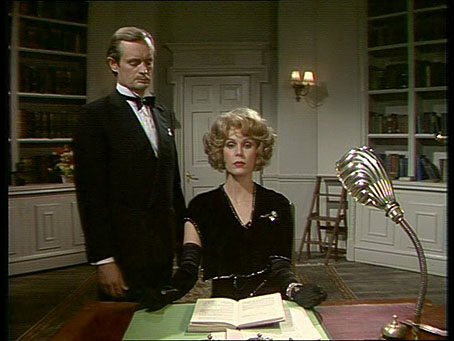
Assignment Five: contact with another ghostly presence.
After the nightmares of the haunted station, Assignment Three came as a disappointment, a poorly conceived piece of science fiction with historians from the distant future visiting the world of 1980. The highlights here aren’t the story but the first appearance of the character of Silver, and the only non-studio shots in the entire series, with Sapphire and Steel on the roof of an office block trying to gain access to an invisible part of the building. Assignment Four concerns another series of hauntings, and is often listed as the series best: a group of sepia-hued Victorian children have been freed from photographs taken 80 years before, while a man with no face is prowling a shabby junk shop. Photographs in this assignment prove to be prisons as much as records of lost time.
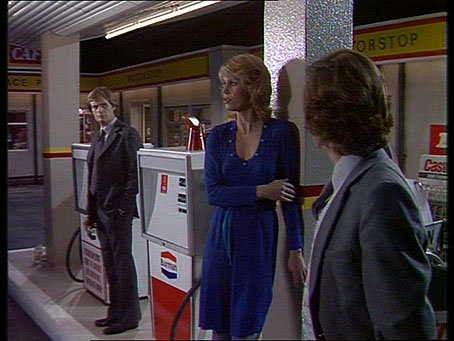
Assignment Six: Silver returns for a final showdown.
Assignment Five is the weakest story of all, and the only one not written by PJ Hammond. Don Haughton and Anthony Read had written for Doctor Who but their script struggles to cohere while throwing together ley lines, viral plagues and Agatha Christie. What might have been a clever twist on country-house murder mysteries or JB Priestley’s An Inspector Calls is frittered away by an unconvincing resolution that reduces Sapphire and Steel to mere spectators. The superior finale, Assignment Six, is a genuine mystery, and all the more puzzling for leaving so much unexplained. PJ Hammond once again makes great use of an isolated, quotidian location—a petrol station and café—for a game of metaphysical cat and mouse. To say more would be to spoil the revelations but the series concludes with one of the most bizarre endings I’ve ever seen in a TV drama.
British television in the early 1980s wasn’t exactly devoid of weirdness: the Logopolis storyline of Doctor Who featured Tom Baker’s Doctor mumbling darkly about entropy while the Universe was falling apart; David Rudkin’s Artemis 81 was also given its only screening at this time. But Sapphire and Steel stands out for its unique collision between the cosmic and the mundanely human, and for alien characters that don’t want to be best friends with human beings. It’s also genuinely scary in places. China Miéville is correct: this really is the strangest thing there’s been on British television.
Sapphire and Steel is all over YouTube but I can’t vouch for the quality of those copies. I was watching the complete DVD set from Network DVD which restores ad break titles cut from earlier editions.
Previously on { feuilleton }
• Children of the Stones
• The Horse of the Invisible

One of my favourites; I was quite suprised that ITV didn’t try a revival after the BBC’s resurrection of Dr. Who. It seemed an obvious candidate given the latter’s success and the dearth of decent adult, home grown Sci-Fi which persists even now. 2000AD runs an occasional strip called ‘Indigo Prime’ which has a similar premise. The best instalment of this, ‘Killing Time’ blends elements of Steampunk, Murder on The Orient Express, Jack the ripper and Lovecraft.
The second assignment is a masterclass in generating dread with minimal resources. It renders the classic props of supernatural fiction precisely that, mere props for something Other whose terror arises from the fact that its barely cognizable.S&S’s aristocratic disdain for the pathetically human ghost-hunter reveals that they too are radically other, adopting human form and affect solely out of necessity. Reminiscent of Under the Skin in that respect.
Its remarkable that such a series could have been beamed into the homes of an unsuspecting Britain by ITV at teatime. They don’t make like this anymore
Modzilla: Yes, this is a familiar scenario in books and comics but very rare on TV. I wouldn’t like to see a reboot, even if PJ Hammond was writing the scripts. I find the current version of Doctor Who insufferable, blighted by the relentless drive to make British drama as dumb as the worst excesses of Hollywood: crap theme tune, bombastic music, everyone running around and shouting all the time, an alien in touch with his human feelings, etc.
That this formula has proved very successful would mean that a rebooted S&S would have to follow suit. The trouble is that small-scale, low-budget things aren’t allowed on television any more. Everything has to be filmed with the highest production values which means a bigger investment and a subsequent demand for a greater return. Hence the widespread dumbing down. I can complain at length about this so I’ll spare you, it’s a pet gripe, and one reason why I shun most TV these days.
Jan: Things like S&S were often able to sneak under the wire partly for the reasons above (less expense) but also there was more confidence that unusual things would find a receptive audience, hence writers like David Rudkin and Dennis Potter being given such a free hand. Changes in the British TV landscape in the 1980s introduced a new level of management dedicated to weeding out things that wouldn’t pull their commercial weight. The consequence of this meant that unusual dramas of any kind disappeared throughout the decade, and writers like Rudkin and co. weren’t asked to contribute scripts.
The extended appreciation of S&S was a joy to read.
Thanks!